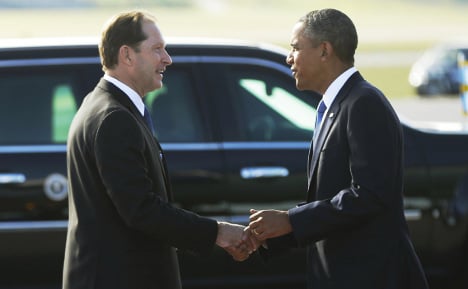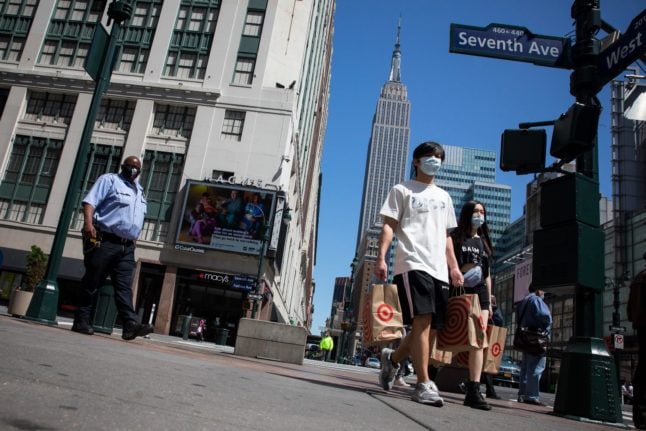UNITED STATES
‘I’m thankful to be US ambassador to Sweden’
As Americans in Sweden and around the world celebrate the Thanksgiving holiday on Thursday, US Ambassador to Sweden Mark Brzezinski explains why he's thankful for the United States' "special relationship" with Sweden.
Published: 28 November 2013 07:51 CET

US Ambassador Mark Brzezinski greets Barack Obama during the US president's visit to Stockholm. File photo: AP
Every November in the United States, we celebrate Thanksgiving by gathering with friends and family, enjoying good food and to give thanks for all that is important in our lives. This November, as I mark my two-year anniversary as the US Ambassador to Sweden, I am particularly thankful for the special relationship between the United States and Sweden. Indeed, as President Barack Obama and Prime Minister Fredrik Reinfeldt put it in their joint statement in September: “Sweden and the United States are very special friends.”
During the past two years, I have traveled around the country and have met with Swedes from all regions of the country and from all walks of life. What I’ve found is a partnership anchored not only in policy, but in people. Whether it’s addressing climate change, advancing human rights and democracy, or promoting greater prosperity, I am thankful for the work our governments and people do to meet global challenges and promote human dignity.
One critical area is the environment. During President Obama’s visit to Stockholm earlier this year, he made one of his highest priorities a visit to KTH in Stockholm to see examples of groundbreaking, clean-energy innovations. His visit also underscored our collaboration on clean technology and combatting climate change. Through the Swedish American Green Alliance (SAGA), a joint initiative between the US and Sweden, we have launched a number of exchange programmes for students, organized conferences and workshops, and built links between American and Swedish companies and universities.
Similarly, in the Arctic, we are working together to safeguard this delicate region. This past May, Sweden concluded its highly successful chairmanship of the Arctic Council – a success we hope to emulate when the US becomes chair in 2015. Last month, I traveled to the Abisko Scientific Research Station, where 110 years of data demonstrate the effects of a warming climate on the Arctic. At the station, I attended a workshop with Fulbright scholars to discuss climate change, governance, and security in the Arctic. US Secretary of State John Kerry said it best earlier this year at the Arctic Council Ministerial in Kiruna: “There is nothing that should unite us quite like our concern for both the promise and the challenges of the northern-most reaches of the earth.”
Promoting human rights and democracy is another shared priority. As former US Secretary of State Clinton noted during her June 2012 visit to Stockholm, “Sweden brings its diplomatic heft and its development expertise to nearly every corner of the globe.” In both Afghanistan and Kosovo, Sweden has worked alongside the United States and our Nato allies and partners to support stability and prosperity. We also cooperate closely on development assistance. Just last week, Dr. Raj Shah, the head of the US Agency for International Development (USAID), visited Sweden to sign two partnerships: one with the Swedish International Development Agency (Sida) for 2.6 billion kronor ($397 million) over five years for collaborative development projects and another with both Sisa and Volvo Group to provide vocational training in Sub-Saharan Africa.
Around the world, Sweden and the United States are following the legacy of the heroic Swedish diplomat Raoul Wallenberg, who saved tens of thousands of Jews during World War II by refusing to be indifferent and advancing the rights of women, gays and lesbians, and others who are persecuted or oppressed. During his recent visit, President Obama also highlighted Wallenberg’s legacy at a commemoration ceremony in Stockholm’s Great Synagogue.
Our cooperation in safeguarding the climate and promoting democracy and human rights is mirrored by our common commitment to advancing economic prosperity. Globally, with half the world living on less than 16 kronor a day, we aim to expand economic opportunity not only through development programmes, but also through increased access to markets and freer and fairer trade.
At the same time, our solid commercial relationship is expanding economic opportunity and creating jobs in Sweden and the United States. Our annual bilateral trade in goods and services is valued at over 162 billion kronor. Sweden is the 13th largest investor in the US and the 273 billion kronor of cumulative Swedish investment has created nearly 200,000 jobs in the United States. The US is also one of the largest investors in Sweden, responsible for an estimated 75,000 jobs. These numbers are good, but they can get better. That’s one reason why the United States and Sweden are two of the strongest advocates for the Transatlantic Trade and Investment Treaty – the proposed free-trade agreement between the United States and European Union. The US embassy has also brought together many leading US and Swedish business representatives. We have supported numerous trade delegations over the past two years from Alabama, Virginia, California, and Minnesota as well as from several US cities.
In closing, on this Thanksgiving Day in the US, I’d like to echo the words of President Obama: “I want to thank Sweden and the Swedish people for being such strong partners in pursuit of these values that we share.”
I’m thankful for the opportunity to advance our strong relationship to new levels over the past two years and look forward to continuing our hard work in deepening and expanding our relationship during the rest of my tenure as ambassador here in Sweden.
Mark Brzezinski
US Ambassador to Sweden
Url copied to clipboard!


 Please whitelist us to continue reading.
Please whitelist us to continue reading.
Member comments